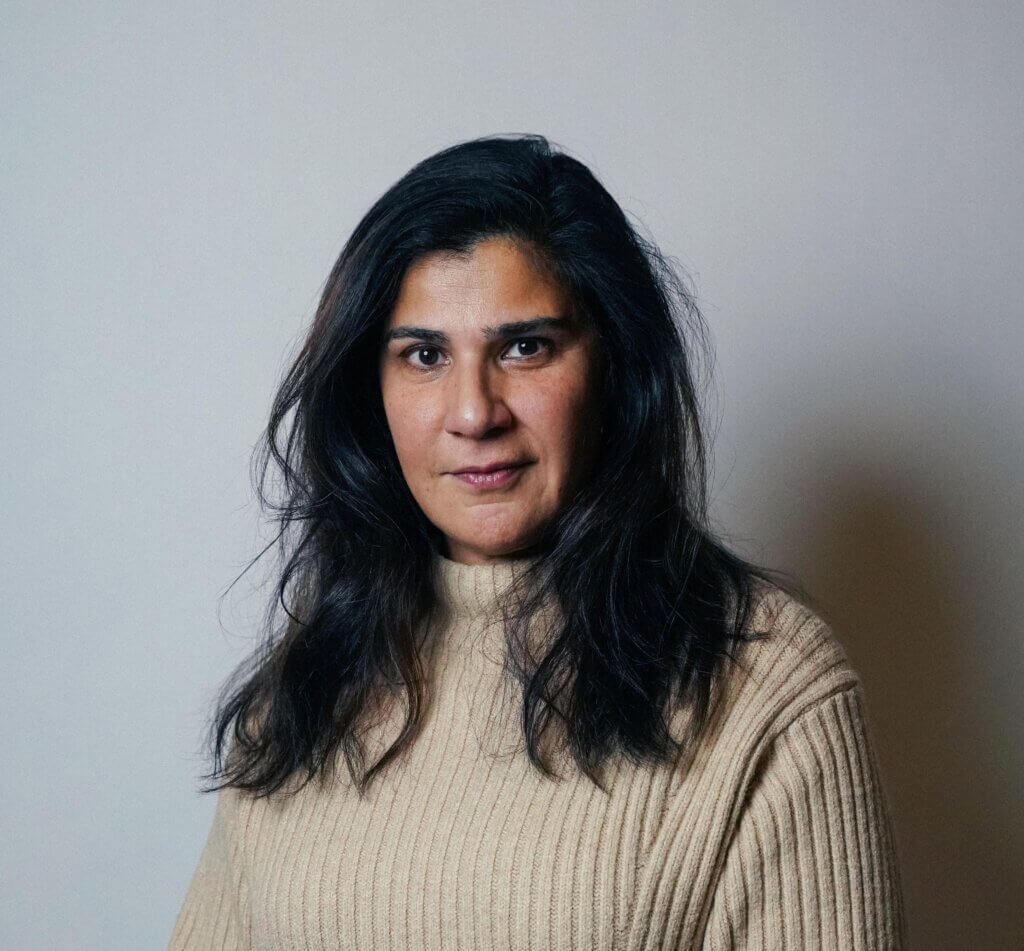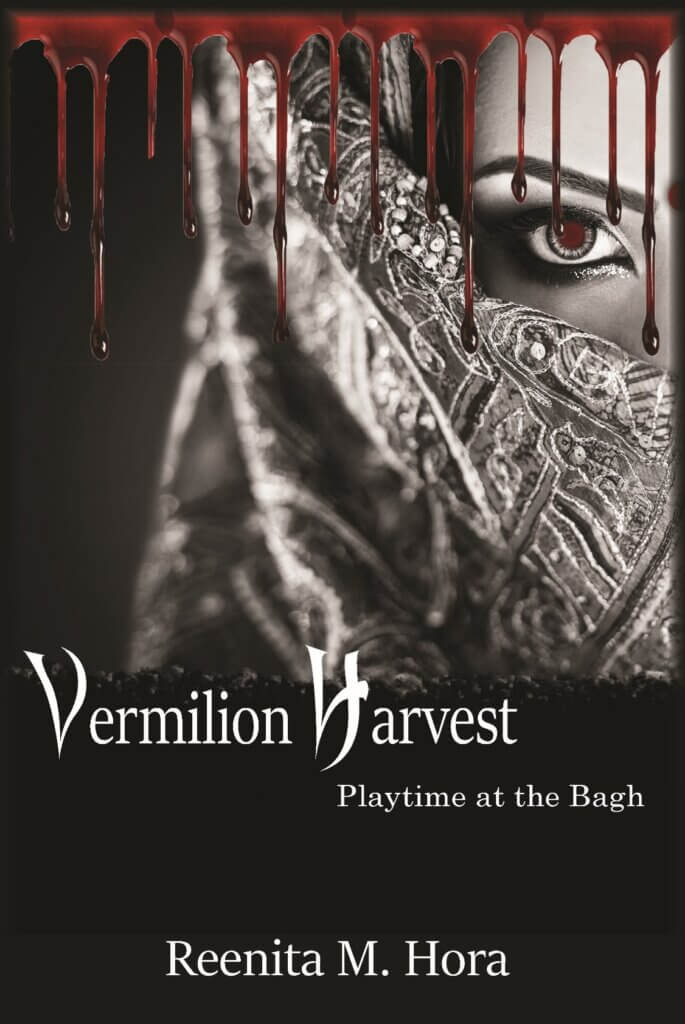Reenita is the unrivaled ‘Nora Ephron’ of South Asian storytelling, spinning yarns as eclectic as Mumbai’s iconic ‘Bhel Puri’ – a tantalizing concoction of flavors with an occasional bug for that extra crunch! Her stories star a motley crew of characters caught in the whirlwind of gloriously imperfect scenarios, all while stubbornly refusing to sell out, and her writing, unapologetically Indian, pulses with the rich colors and rhythms of her culture, deftly blending humor and authenticity.
LA Weekly has dubbed her a top Indie writer bringing Indian culture and humor to American audiences.

In her previous life, Reenita was a journalist, editor, and writer for platforms like National Geographic Kids, Disney India, Cartoon Network Asia, the New York Times, CNN, Radio Television Hong Kong, and Bloomberg. Her awards and accolades include the Eric Hoffer Book Award, IndieReader Discovery Award, Santa Barbara International Screenplay Award, Script2Comic, Launchpad, and Emerging Screenwriters awards, and second round consideration (OPERATION MOM) for the Sundance Institute Development Slate. No one-trick pony though, she’s the brains behind not one but two rib-tickling podcasts: the ‘True Fiction Project’ (where reality takes a hilarious nosedive into the scripted world) and ‘Shadow Realm’ (a magical portal to riveting narrative fiction). She’s honed her screenwriting skills through topnotch programs like Writers’ Bootcamp and Roadmap Writers, so you know she means business.
In this interview, Screenplay Writer and Playwright, Reenita Hora dives deep into her new release Vermillion Harvest, and its root in her South Asian heritage. Let’s explore!
1. How do you balance the authenticity of your South Asian heritage with the need to make your stories accessible to a global audience?
I’m on a mission to share the vibrant, hilarious, and often misunderstood stories of the South Asian experience—because that’s my world! Too often, people lump us all into one stereotype, but I’m here to highlight the rich diversity of our stories and make them relatable to everyone. First off, not all South Asians are cut from the same cloth! Growing up in South Asia is a different adventure than navigating life in America, the UK, or Australia. Even within the U.S., the dynamics can vary wildly. You’ve got fresh-off-the-boat relatives, first- generation kids balancing two worlds, and seasoned pros who can ace a Bollywood dance-off at family weddings. Each character has a unique tale, and I’m here to explore them all! And hey, LA Weekly even named me one of the top indie authors reinventing Indian humor and culture in America! Check it out: LA Weekly Article.
2. What inspired you to set “Vermilion Harvest – Playtime at the Bagh” against the backdrop of
the 1919 Jallianwallah Bagh massacre?
I’m deeply connected to the Jallianwala Bagh massacre through my late grandfather’s vivid memories of the aftermath he witnessed as a young boy in Amritsar. This connection also inspired a character I portrayed in a related play during my teenage years, igniting my passion for storytelling—especially after reading Erich Segal’s Love Story. That’s when I knew I wanted to craft my own epic love story, a dream that solidified further after watching Titanic. Incorporating elements of heritage and personal experience into my writing is essential.
My stories often unfold in places that resonate deeply—Mumbai, San Francisco, Punjab. As a Punjabi, the tragedy of Amritsar strikes a profound chord. With my grandfather from there and my mother born there, the massacre feels intensely personal. Official records cite 379 deaths and about 1,500 injuries, but estimates suggest the toll could be as high as 1,500, with the true numbers shrouded in mystery. General Dyer’s sudden attack inflicted devastation in mere minutes, rivaling tragedies like 9/11. This horrific event was a turning point for the Indian independence movement, igniting a nationwide push for freedom that culminated in 1947. As Saugata Mukherjee, head of content at Warner India, aptly noted, it was “one of the darkest moments in modern Indian history.” Lynn Moon from Indignor House even compared General Dyer to Hitler, a comparison that resonates deeply. Though I learned about this tragedy in school, many outside India remain unaware of its significance. Despite its monumental impact, the Jallianwala Bagh massacre has largely faded from global historical memory. That’s why I felt compelled to write about it—to shed light on a crucial chapter of history that the world needs to confront and remember. As a friend pointed out, while we didn’t live through that era, this is my way of supporting the freedom fighters of colonial India.

3. How did you approach the delicate task of writing about such a politically tense period in
Amritsar? Did you encounter any challenges, and how did you overcome them?
Tackling my research was like navigating a labyrinth—where to even begin was a puzzle in itself. Fortunately, a friend of mine, a history professor at Wellesley College, came to my rescue. With his help, I got my hands on General Dyer’s court transcripts, providing a rare glimpse into Dyer’s mindset, albeit post-massacre. I then delved into the geography of Amritsar, poring over maps and studying the city’s layout. I imagined where young lovers might have strolled, and the ‘pop culture’ of the time i.e. the cultural touchpoints that could have brought them together—Jane Austen seemed an obvious choice for a school teacher and an English-educated Muslim law student. I also pinpointed where political protests occurred and mapped out General Dyer’s movements. Researching the events leading up to the massacre revealed numerous incidents that nearly sparked major conflicts but were thankfully avoided. This thorough research demanded time, patience, and dedication. My goal was to publish the book in 2019, marking a hundred years since the event. However, as I began writing
in 2018, I realized that rushing would do the subject a disservice. So, I chose to take my time and approach the project with the care it deserved, free from the pressure of an unrealistic deadline.
4. The love story in your book is not a typical romance. How do you think the political tensions
and cultural differences add depth to the relationship between the Anglo-Indian schoolteacher
and the Muslim student activist?
The love story in my book isn’t your typical romance. The political tensions and cultural differences add significant depth to the relationship between the Anglo-Indian schoolteacher, Aruna, and the Muslim student activist, Ayaz. Interfaith issues have long been a thorny problem in South Asia and remain so today. While Hindu-Muslim relationships might be more common in the US, they are still far from the norm in the Indian subcontinent. This novel delves into themes of gender roles, power, and identity, focusing on an Anglo-Indian protagonist marginalized by both Indians and the British. Aruna is caught between two worlds, rejected by her mother’s Hindu Punjabi community and her father’s British society. This dual rejection highlights the societal acceptance of Anglo-Indians, which contrasts sharply with the melting pot mentality of America both then and now—a different kind of “untouchable.”
Aruna is acutely aware that she is outcast from both sides of her heritage, making her acceptance into Ayaz’s Muslim family impossible. Ayaz, himself, is no simple character. As a Home Rule activist, he is deeply involved with the Indian National Congress, prioritizing its pro-independence activities over his studies. Although he is officially a student in Lahore, he has come to Amritsar to follow local Congress leaders Saifuddin Kitchlew and Dr. Satyapal, who are devoted to the Home Rule movement. His activism draws constant scrutiny from the British government, labeling him a troublemaker and an anti-seditionist, effectively a threat to British rule. Aruna is unsettled by all of this. Ayaz’s devotion to activism over their romance, combined with the constant surveillance he faces, threatens to derail their budding relationship. This tension adds a layer of complexity and realism to their love story.
5. Are there any particular characters in your books or screenplays that you feel especially
connected to? Why?
Oh, absolutely! I feel a deep connection to every protagonist in my stories. Whether they are male, female, old, or young, and whether they exist in my historical fiction, comedy, fantasy, literary non-fiction, or screenplays, each character is a reflection of some part of me. Plus, all my characters are a mix of the real people in my life, which gives me endless material to work with! I especially connect with Veena and Ila from “Operation Mom,” Arya from my narrative fantasy fiction podcast “Shadow Realm,” and Aruna from “Vermilion Harvest.” These characters are strong and feisty, yet they have serious flaws that make them lovable and relatable. They find themselves on a wild ride of imperfect scenarios but refuse to sell out. That’s me in a nutshell! Creating these stories is my way of exploring different facets of my personality and experiences. It’s like having a conversation with different versions of myself, each with their unique quirks and strengths. That’s what makes writing so exhilarating for me!
6. Can you walk us through your writing process? Do you have any rituals or routines that help
you get into the creative zone?
Absolutely! I remember attending a conference where Ariel Richardson, the children’s editor at Chronicle Books, shared a gem of wisdom: “All good ideas come into your head during the process of showering.” Her takeaway? Take long showers. For me, it’s all about taking a hike—literally. Whether I’m walking on the beach or through the city, being by myself is crucial. I need that alone time to think and create, to step away from my nuclear family and the constant buzz of everyday life. No doorbells, no interruptions, no chit-chat—just me and my thoughts. That’s when ideas take root and start to flourish. Once they do, it’s all about getting to my laptop and synthesizing those thoughts into something tangible.
In these quiet, solitary moments, my best ideas are born, ready to be shaped into the
characters and stories I love to create.
7. How do you handle writer’s block or moments of creative doubt?
I don’t believe in writer’s block. Just look around—your everyday world is brimming with story fodder! The mundane, the extraordinary, and everything in between are ripe for inspiration. Creative doubt? What’s that? If you mean the hesitation of “Can I take creative license with this story?” then let me tell you—that’s the whole thrill of writing fiction! You get to make the rules, bend them, and have a blast doing it. Embrace the freedom to shape your narrative, play with possibilities, and let your imagination run wild. The world is your canvas, and every moment is a potential masterpiece waiting to be written.
8. How do you hope your readers will react to “Vermilion Harvest – Playtime at the Bagh”? What emotions or thoughts do you want to evoke?
The main message I hope readers take away from Vermilion Harvest is the profound duality of life—how beauty and tragedy, creation and destruction, are intertwined, symbolized by the color vermilion. This vibrant hue, which adorns the hair parting of a married Hindu woman, represents both life and vitality as well as the bloodshed during tragic events like the Jallianwala Bagh massacre. In a poignant twist, Ayaz applies vermilion to Aruna’s hair the last time he sees her, marking her as his bride in an unofficial act of Hindu marriage, but tragically also sealing her fate as a widow within hours. Vermilion, or sindhur, traditionally signifies both the zest of life and commitment in marriage—central elements to the relationship between Aruna and Ayaz. Yet, this same color also mirrors the blood spilled on Baisakhi in 1919 during the horrifying massacre at Jallianwala Bagh, highlighting the stark contrast between celebration and calamity. The subtitle, Playtime at the Bagh, deepens this metaphor. It refers to the innocent gatherings during the Baisakhi harvest festival, which tragically turned into a deadly
“game” of bullets under General Dyer’s orders. This historical backdrop serves as a somber reminder of the brutal impacts of colonial exploitation, mirrored in Aruna’s personal story. Her Anglo-Indian heritage stems from violence—her Hindu mother was assaulted by a British officer, echoing the broader pillaging of India by its colonizers. Through Vermilion Harvest, I aim to delve into the complexities of historical trauma, the enduring scars of colonialism, and the resilient spirit that emerges from understanding and reconciling these deep-seated wounds. In 2019, during the 100th anniversary of the massacre, there was a move by Indians to request an apology from Queen Elizabeth II of England, which didn’t happen. It’s shameful that thousands can die in a planned terrorist attack, and yet it remains largely unknown. There has never been a fictional story set against this massacre either.
Furthermore, the issues raised in the book are incredibly relevant today. Even in India, recent freedom of expression issues beg the question: Have we learned anything in the past 100 years, both in India and around the world? It is unacceptable that such planned terrorist attacks are forgotten and swept under the carpet, with no lessons learned.
9. Can you give us a sneak peek into any upcoming projects or themes you are excited to
explore in the future, and how do you see the evolution of your storytelling style in the coming
years?
Yes, of course! I’m thrilled to share some exciting upcoming projects that I’ve been working
on. Here’s what’s on the horizon:
- Ace of Blades : This is a literary non-fiction story about my father, RK Malhotra, the pioneer
of India’s razor blade industry. He was a relentless visionary who wouldn’t stop at anything to
build this industry—not just his business, but the entire industry—even if it cost him his own
family. Think of it as Succession meets The Crown, but with an Indian twist. It’s a compelling
tale of ambition, family conflict, and the sacrifices made for success. - Festivals of Light: This picture book follows a Jewish girl and a Hindu girl as they celebrate
Diwali and Hanukkah together. It’s a heartwarming story that highlights cultural diversity and
the beauty of shared traditions. Perfect for teaching children about the richness of different
cultures through the lens of friendship and light. - Sundri & Mundri’s Lohri Adventure: Set during the contemporary California celebration of
Punjab’s winter harvest festival, this fantasy picture book takes young readers on an
enchanting adventure with Sundri and Mundri. It’s a whimsical tale that brings the vibrancy of
Punjabi culture to life. - Shadow Realm: The Arya Chronicles Series The most exciting project on my list is Shadow
Realm, which is part one of the Arya Chronicles series, based on my already-released podcast. This narrative fantasy fiction book thrusts 16-year-old Arya into a supernatural war where his South Asian heritage is targeted by demons. When bullies in San Francisco steal his sacred Ramayana book, chaos ensues, leading to a life-threatening accident for his mother.
If all goes well, I plan to spend the next five years developing Shadow Realm and the Arya
Chronicles series. This will be the first-ever superhero-type story drawing from Vedic mythology, and I can’t wait to see it come to life.
The Evolution of My Storytelling Style
As I look to the future, I see my storytelling evolving in several exciting ways. I aim to delve deeper into blending historical context with rich, character-driven narratives, as seen in Operation Mom, Vermilion Harvest and Ace of Blades. I’m also keen to explore more multicultural themes and fantastical elements, bringing a fresh perspective to traditional stories and legends, including my comedy books and screenplays.
My goal is to create immersive worlds that not only entertain but also provoke thought and empathy. I want my stories to resonate on a personal level while shedding light on broader social and cultural issues. By intertwining the past with the present, and reality with comedy and fantasy, I hope to continue crafting compelling narratives that captivate and inspire readers and film viewers of all ages.
10. What advice would you give to aspiring writers who want to incorporate their cultural
heritage into their work?
When it comes to weaving your heritage into your work, the key is to be real and go deep. The world often thinks it knows our stories, but they’re usually bound by stereotypes and superficial narratives. It’s up to you to break through those barriers and reveal the truths only you can tell.
- Dig into the Roots and Embrace Complexity:
Go beyond surface-level depictions and dive into the rich history, traditions, and personal anecdotes that shape your heritage. Embrace the duality of your cultural background, showing how beauty and tragedy coexist and influence your identity. - Challenge Stereotypes and Use Specific Details:
Present characters and scenarios that defy stereotypes, showcasing the diversity within
your culture. Use specific cultural details—such as dishes, festivals, and rituals—to
create a vivid and authentic backdrop for your narrative. - Be Vulnerable and Connect Past to Present:
Open up about personal experiences, including struggles and triumphs, to build deep
connections with your audience. Show how your heritage evolves over time and
continues to influence contemporary life, linking the past with the present to offer
profound insights into cultural identity.
What’s next? Brace yourself for ‘Festival of Lights‘ published by Harper Collins coming soon to a bookshelf near you! Dive headfirst into her world of hilarity, fantastical tales, and laugh-out-loud moments at http://www.reenita.com. And, don’t forget your bug spray!





